Management Principles: Organizational Structure and Strategy Report
VerifiedAdded on 2019/12/04
|9
|2610
|134
Report
AI Summary
This report provides a comprehensive overview of key management principles. It begins by outlining the different levels of managerial need within an organization, emphasizing the distinctions between top, middle, and lower-level management roles. The report then delves into the comparison of organic and mechanistic organizational structures, highlighting their characteristics, advantages, and disadvantages. Furthermore, it examines the characteristics of informational leadership, including internal motivation, decision-making abilities, and risk-taking behaviors. The report also explores the strategic management process, detailing the steps involved in developing organizational strategies, from defining objectives and assessing the environment to setting quantitative targets and analyzing performance. The report concludes by emphasizing the importance of effective management principles for organizational success. This document, contributed by a student, is available on Desklib, a platform providing AI-based study tools for students.
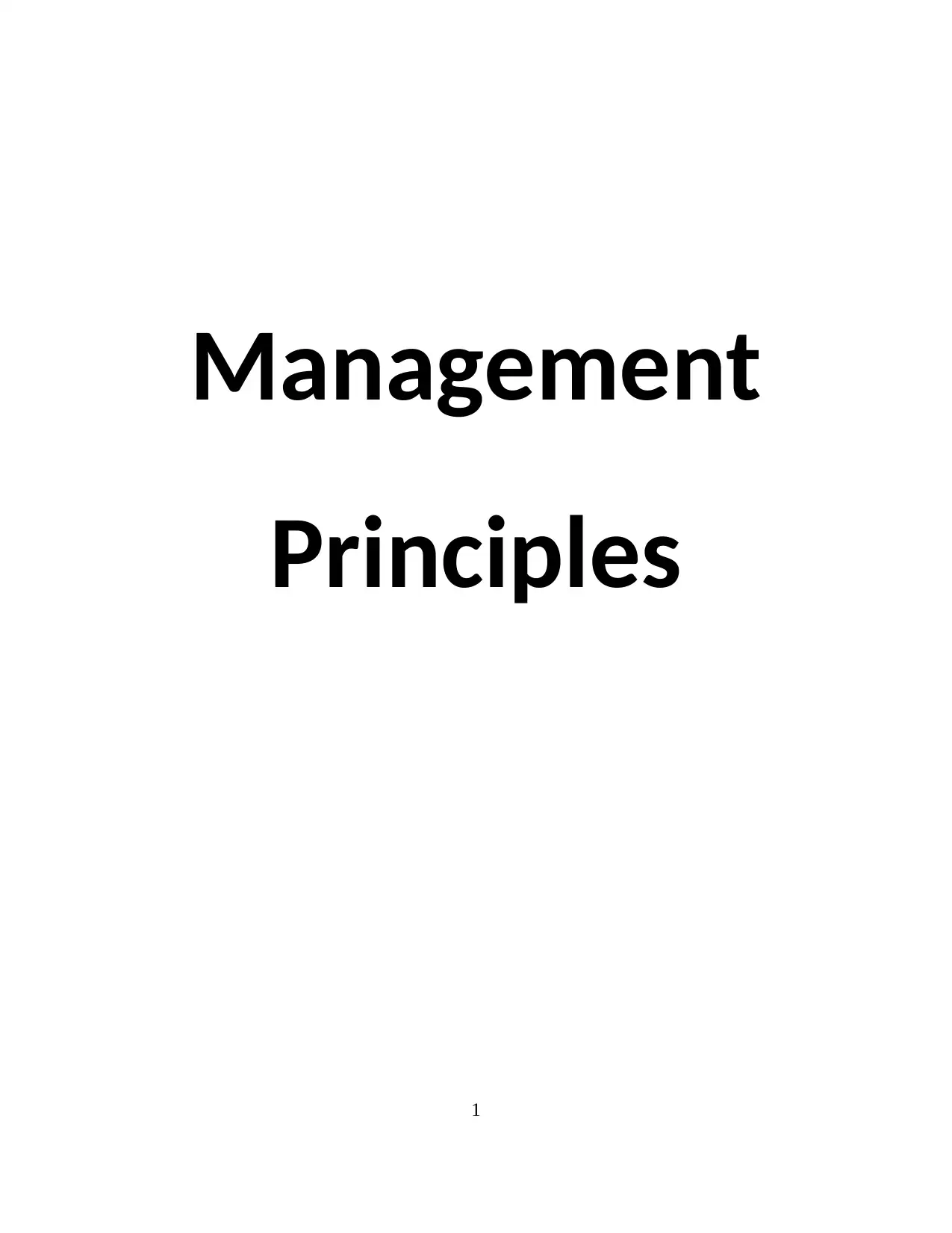
Management
Principles
1
Principles
1
Paraphrase This Document
Need a fresh take? Get an instant paraphrase of this document with our AI Paraphraser
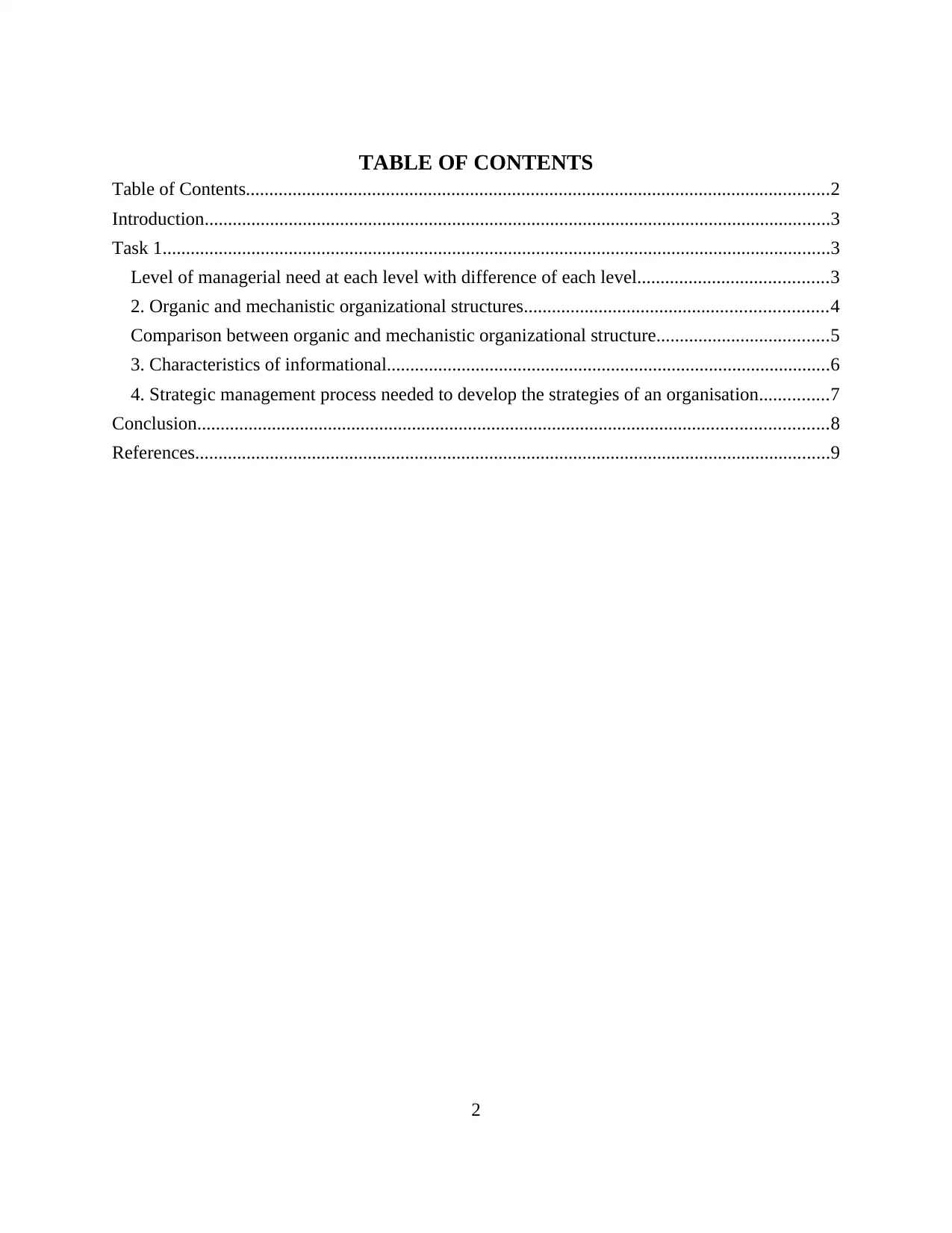
TABLE OF CONTENTS
Table of Contents.............................................................................................................................2
Introduction......................................................................................................................................3
Task 1...............................................................................................................................................3
Level of managerial need at each level with difference of each level.........................................3
2. Organic and mechanistic organizational structures.................................................................4
Comparison between organic and mechanistic organizational structure.....................................5
3. Characteristics of informational...............................................................................................6
4. Strategic management process needed to develop the strategies of an organisation...............7
Conclusion.......................................................................................................................................8
References........................................................................................................................................9
2
Table of Contents.............................................................................................................................2
Introduction......................................................................................................................................3
Task 1...............................................................................................................................................3
Level of managerial need at each level with difference of each level.........................................3
2. Organic and mechanistic organizational structures.................................................................4
Comparison between organic and mechanistic organizational structure.....................................5
3. Characteristics of informational...............................................................................................6
4. Strategic management process needed to develop the strategies of an organisation...............7
Conclusion.......................................................................................................................................8
References........................................................................................................................................9
2
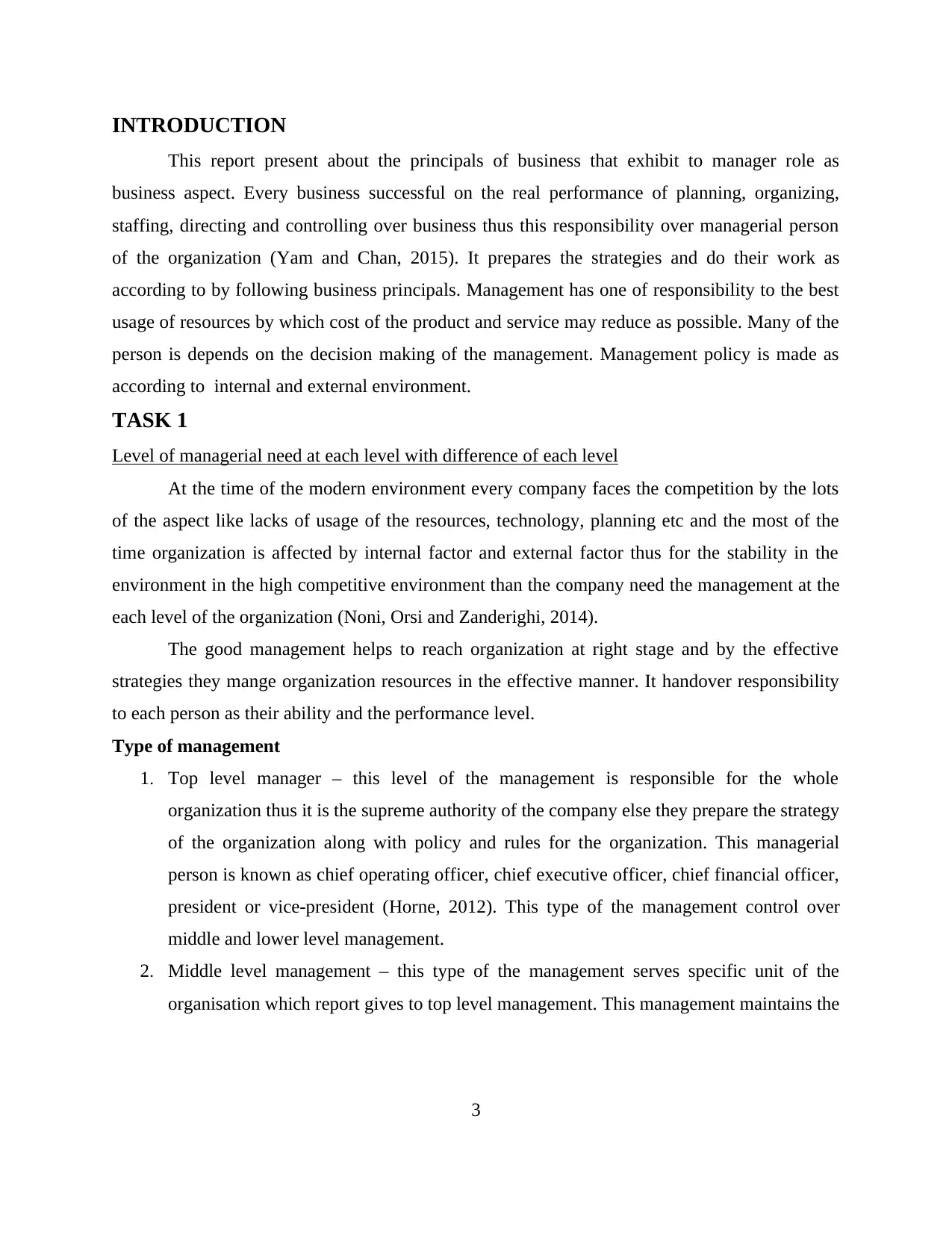
INTRODUCTION
This report present about the principals of business that exhibit to manager role as
business aspect. Every business successful on the real performance of planning, organizing,
staffing, directing and controlling over business thus this responsibility over managerial person
of the organization (Yam and Chan, 2015). It prepares the strategies and do their work as
according to by following business principals. Management has one of responsibility to the best
usage of resources by which cost of the product and service may reduce as possible. Many of the
person is depends on the decision making of the management. Management policy is made as
according to internal and external environment.
TASK 1
Level of managerial need at each level with difference of each level
At the time of the modern environment every company faces the competition by the lots
of the aspect like lacks of usage of the resources, technology, planning etc and the most of the
time organization is affected by internal factor and external factor thus for the stability in the
environment in the high competitive environment than the company need the management at the
each level of the organization (Noni, Orsi and Zanderighi, 2014).
The good management helps to reach organization at right stage and by the effective
strategies they mange organization resources in the effective manner. It handover responsibility
to each person as their ability and the performance level.
Type of management
1. Top level manager – this level of the management is responsible for the whole
organization thus it is the supreme authority of the company else they prepare the strategy
of the organization along with policy and rules for the organization. This managerial
person is known as chief operating officer, chief executive officer, chief financial officer,
president or vice-president (Horne, 2012). This type of the management control over
middle and lower level management.
2. Middle level management – this type of the management serves specific unit of the
organisation which report gives to top level management. This management maintains the
3
This report present about the principals of business that exhibit to manager role as
business aspect. Every business successful on the real performance of planning, organizing,
staffing, directing and controlling over business thus this responsibility over managerial person
of the organization (Yam and Chan, 2015). It prepares the strategies and do their work as
according to by following business principals. Management has one of responsibility to the best
usage of resources by which cost of the product and service may reduce as possible. Many of the
person is depends on the decision making of the management. Management policy is made as
according to internal and external environment.
TASK 1
Level of managerial need at each level with difference of each level
At the time of the modern environment every company faces the competition by the lots
of the aspect like lacks of usage of the resources, technology, planning etc and the most of the
time organization is affected by internal factor and external factor thus for the stability in the
environment in the high competitive environment than the company need the management at the
each level of the organization (Noni, Orsi and Zanderighi, 2014).
The good management helps to reach organization at right stage and by the effective
strategies they mange organization resources in the effective manner. It handover responsibility
to each person as their ability and the performance level.
Type of management
1. Top level manager – this level of the management is responsible for the whole
organization thus it is the supreme authority of the company else they prepare the strategy
of the organization along with policy and rules for the organization. This managerial
person is known as chief operating officer, chief executive officer, chief financial officer,
president or vice-president (Horne, 2012). This type of the management control over
middle and lower level management.
2. Middle level management – this type of the management serves specific unit of the
organisation which report gives to top level management. This management maintains the
3
⊘ This is a preview!⊘
Do you want full access?
Subscribe today to unlock all pages.

Trusted by 1+ million students worldwide
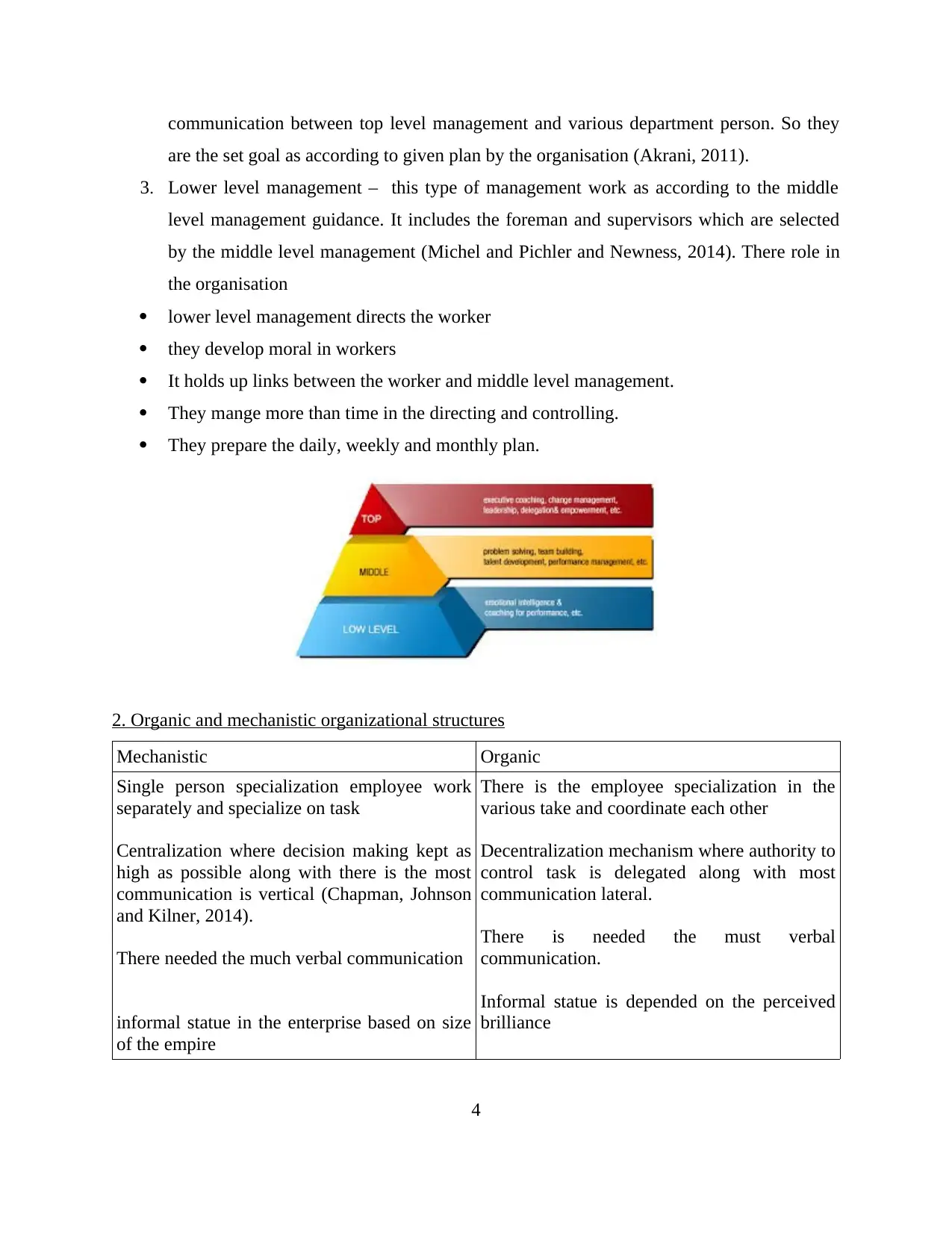
communication between top level management and various department person. So they
are the set goal as according to given plan by the organisation (Akrani, 2011).
3. Lower level management – this type of management work as according to the middle
level management guidance. It includes the foreman and supervisors which are selected
by the middle level management (Michel and Pichler and Newness, 2014). There role in
the organisation
lower level management directs the worker
they develop moral in workers
It holds up links between the worker and middle level management.
They mange more than time in the directing and controlling.
They prepare the daily, weekly and monthly plan.
2. Organic and mechanistic organizational structures
Mechanistic Organic
Single person specialization employee work
separately and specialize on task
Centralization where decision making kept as
high as possible along with there is the most
communication is vertical (Chapman, Johnson
and Kilner, 2014).
There needed the much verbal communication
informal statue in the enterprise based on size
of the empire
There is the employee specialization in the
various take and coordinate each other
Decentralization mechanism where authority to
control task is delegated along with most
communication lateral.
There is needed the must verbal
communication.
Informal statue is depended on the perceived
brilliance
4
are the set goal as according to given plan by the organisation (Akrani, 2011).
3. Lower level management – this type of management work as according to the middle
level management guidance. It includes the foreman and supervisors which are selected
by the middle level management (Michel and Pichler and Newness, 2014). There role in
the organisation
lower level management directs the worker
they develop moral in workers
It holds up links between the worker and middle level management.
They mange more than time in the directing and controlling.
They prepare the daily, weekly and monthly plan.
2. Organic and mechanistic organizational structures
Mechanistic Organic
Single person specialization employee work
separately and specialize on task
Centralization where decision making kept as
high as possible along with there is the most
communication is vertical (Chapman, Johnson
and Kilner, 2014).
There needed the much verbal communication
informal statue in the enterprise based on size
of the empire
There is the employee specialization in the
various take and coordinate each other
Decentralization mechanism where authority to
control task is delegated along with most
communication lateral.
There is needed the must verbal
communication.
Informal statue is depended on the perceived
brilliance
4
Paraphrase This Document
Need a fresh take? Get an instant paraphrase of this document with our AI Paraphraser
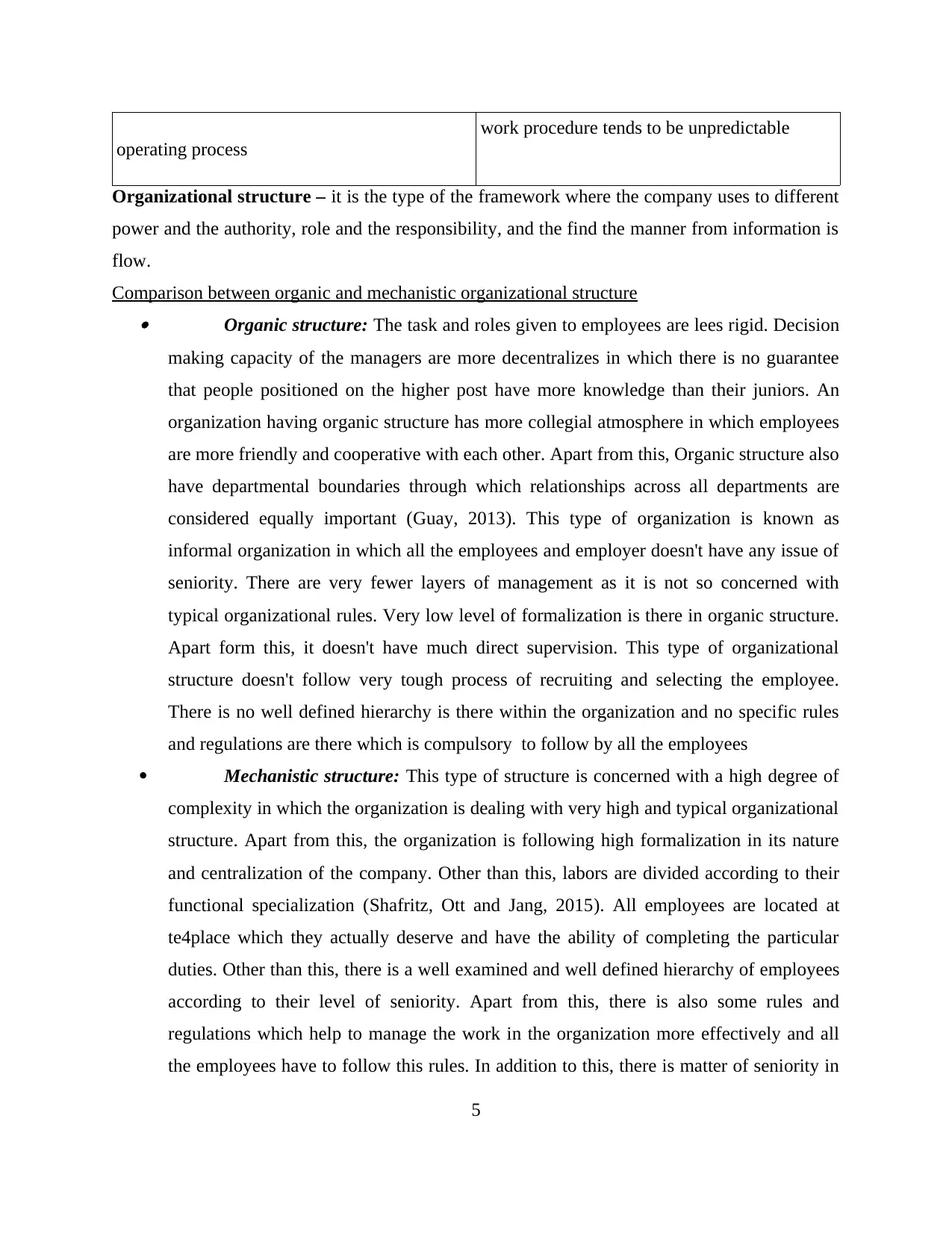
operating process
work procedure tends to be unpredictable
Organizational structure – it is the type of the framework where the company uses to different
power and the authority, role and the responsibility, and the find the manner from information is
flow.
Comparison between organic and mechanistic organizational structure Organic structure: The task and roles given to employees are lees rigid. Decision
making capacity of the managers are more decentralizes in which there is no guarantee
that people positioned on the higher post have more knowledge than their juniors. An
organization having organic structure has more collegial atmosphere in which employees
are more friendly and cooperative with each other. Apart from this, Organic structure also
have departmental boundaries through which relationships across all departments are
considered equally important (Guay, 2013). This type of organization is known as
informal organization in which all the employees and employer doesn't have any issue of
seniority. There are very fewer layers of management as it is not so concerned with
typical organizational rules. Very low level of formalization is there in organic structure.
Apart form this, it doesn't have much direct supervision. This type of organizational
structure doesn't follow very tough process of recruiting and selecting the employee.
There is no well defined hierarchy is there within the organization and no specific rules
and regulations are there which is compulsory to follow by all the employees
Mechanistic structure: This type of structure is concerned with a high degree of
complexity in which the organization is dealing with very high and typical organizational
structure. Apart from this, the organization is following high formalization in its nature
and centralization of the company. Other than this, labors are divided according to their
functional specialization (Shafritz, Ott and Jang, 2015). All employees are located at
te4place which they actually deserve and have the ability of completing the particular
duties. Other than this, there is a well examined and well defined hierarchy of employees
according to their level of seniority. Apart from this, there is also some rules and
regulations which help to manage the work in the organization more effectively and all
the employees have to follow this rules. In addition to this, there is matter of seniority in
5
work procedure tends to be unpredictable
Organizational structure – it is the type of the framework where the company uses to different
power and the authority, role and the responsibility, and the find the manner from information is
flow.
Comparison between organic and mechanistic organizational structure Organic structure: The task and roles given to employees are lees rigid. Decision
making capacity of the managers are more decentralizes in which there is no guarantee
that people positioned on the higher post have more knowledge than their juniors. An
organization having organic structure has more collegial atmosphere in which employees
are more friendly and cooperative with each other. Apart from this, Organic structure also
have departmental boundaries through which relationships across all departments are
considered equally important (Guay, 2013). This type of organization is known as
informal organization in which all the employees and employer doesn't have any issue of
seniority. There are very fewer layers of management as it is not so concerned with
typical organizational rules. Very low level of formalization is there in organic structure.
Apart form this, it doesn't have much direct supervision. This type of organizational
structure doesn't follow very tough process of recruiting and selecting the employee.
There is no well defined hierarchy is there within the organization and no specific rules
and regulations are there which is compulsory to follow by all the employees
Mechanistic structure: This type of structure is concerned with a high degree of
complexity in which the organization is dealing with very high and typical organizational
structure. Apart from this, the organization is following high formalization in its nature
and centralization of the company. Other than this, labors are divided according to their
functional specialization (Shafritz, Ott and Jang, 2015). All employees are located at
te4place which they actually deserve and have the ability of completing the particular
duties. Other than this, there is a well examined and well defined hierarchy of employees
according to their level of seniority. Apart from this, there is also some rules and
regulations which help to manage the work in the organization more effectively and all
the employees have to follow this rules. In addition to this, there is matter of seniority in
5
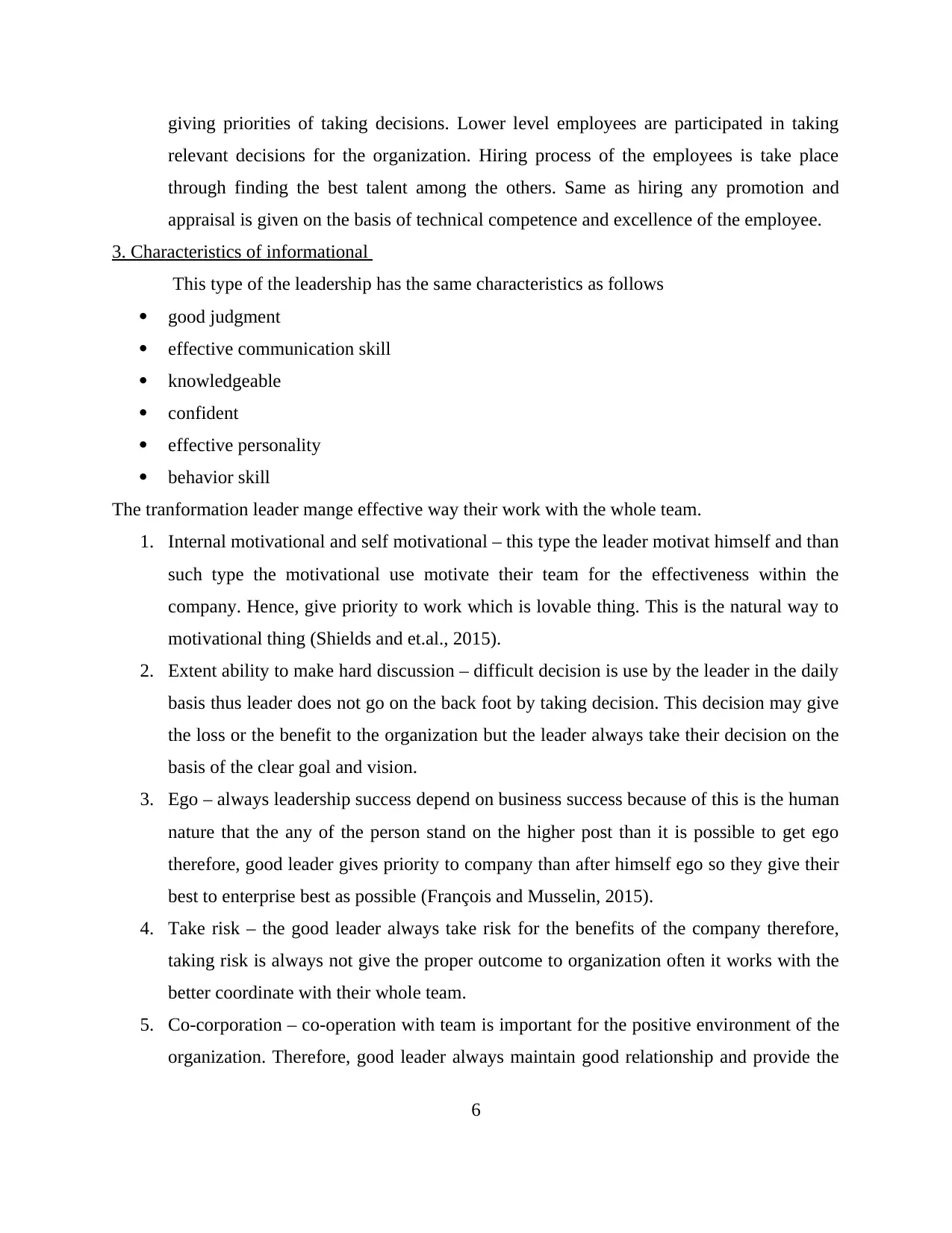
giving priorities of taking decisions. Lower level employees are participated in taking
relevant decisions for the organization. Hiring process of the employees is take place
through finding the best talent among the others. Same as hiring any promotion and
appraisal is given on the basis of technical competence and excellence of the employee.
3. Characteristics of informational
This type of the leadership has the same characteristics as follows
good judgment
effective communication skill
knowledgeable
confident
effective personality
behavior skill
The tranformation leader mange effective way their work with the whole team.
1. Internal motivational and self motivational – this type the leader motivat himself and than
such type the motivational use motivate their team for the effectiveness within the
company. Hence, give priority to work which is lovable thing. This is the natural way to
motivational thing (Shields and et.al., 2015).
2. Extent ability to make hard discussion – difficult decision is use by the leader in the daily
basis thus leader does not go on the back foot by taking decision. This decision may give
the loss or the benefit to the organization but the leader always take their decision on the
basis of the clear goal and vision.
3. Ego – always leadership success depend on business success because of this is the human
nature that the any of the person stand on the higher post than it is possible to get ego
therefore, good leader gives priority to company than after himself ego so they give their
best to enterprise best as possible (François and Musselin, 2015).
4. Take risk – the good leader always take risk for the benefits of the company therefore,
taking risk is always not give the proper outcome to organization often it works with the
better coordinate with their whole team.
5. Co-corporation – co-operation with team is important for the positive environment of the
organization. Therefore, good leader always maintain good relationship and provide the
6
relevant decisions for the organization. Hiring process of the employees is take place
through finding the best talent among the others. Same as hiring any promotion and
appraisal is given on the basis of technical competence and excellence of the employee.
3. Characteristics of informational
This type of the leadership has the same characteristics as follows
good judgment
effective communication skill
knowledgeable
confident
effective personality
behavior skill
The tranformation leader mange effective way their work with the whole team.
1. Internal motivational and self motivational – this type the leader motivat himself and than
such type the motivational use motivate their team for the effectiveness within the
company. Hence, give priority to work which is lovable thing. This is the natural way to
motivational thing (Shields and et.al., 2015).
2. Extent ability to make hard discussion – difficult decision is use by the leader in the daily
basis thus leader does not go on the back foot by taking decision. This decision may give
the loss or the benefit to the organization but the leader always take their decision on the
basis of the clear goal and vision.
3. Ego – always leadership success depend on business success because of this is the human
nature that the any of the person stand on the higher post than it is possible to get ego
therefore, good leader gives priority to company than after himself ego so they give their
best to enterprise best as possible (François and Musselin, 2015).
4. Take risk – the good leader always take risk for the benefits of the company therefore,
taking risk is always not give the proper outcome to organization often it works with the
better coordinate with their whole team.
5. Co-corporation – co-operation with team is important for the positive environment of the
organization. Therefore, good leader always maintain good relationship and provide the
6
⊘ This is a preview!⊘
Do you want full access?
Subscribe today to unlock all pages.

Trusted by 1+ million students worldwide
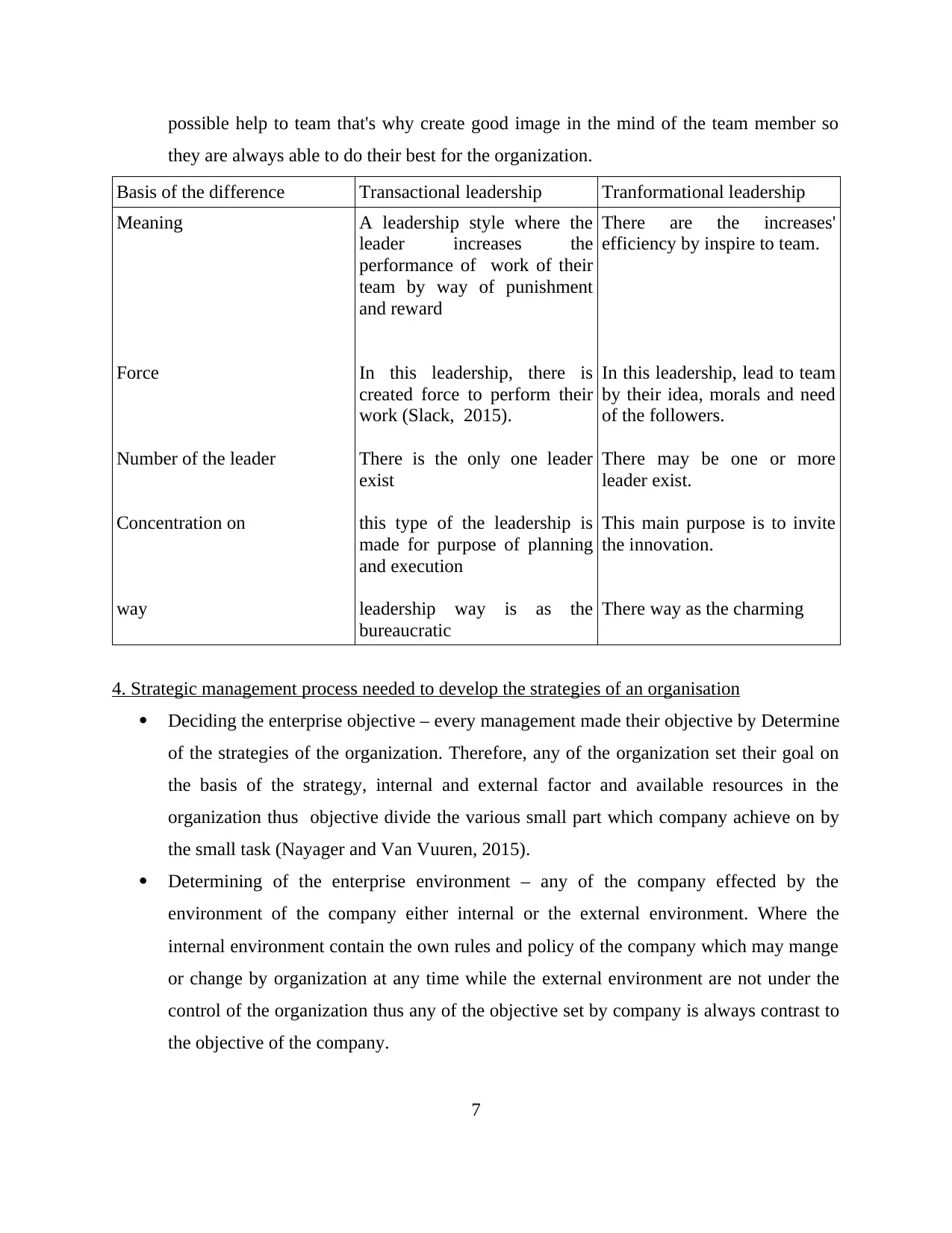
possible help to team that's why create good image in the mind of the team member so
they are always able to do their best for the organization.
Basis of the difference Transactional leadership Tranformational leadership
Meaning
Force
Number of the leader
Concentration on
way
A leadership style where the
leader increases the
performance of work of their
team by way of punishment
and reward
In this leadership, there is
created force to perform their
work (Slack, 2015).
There is the only one leader
exist
this type of the leadership is
made for purpose of planning
and execution
leadership way is as the
bureaucratic
There are the increases'
efficiency by inspire to team.
In this leadership, lead to team
by their idea, morals and need
of the followers.
There may be one or more
leader exist.
This main purpose is to invite
the innovation.
There way as the charming
4. Strategic management process needed to develop the strategies of an organisation
Deciding the enterprise objective – every management made their objective by Determine
of the strategies of the organization. Therefore, any of the organization set their goal on
the basis of the strategy, internal and external factor and available resources in the
organization thus objective divide the various small part which company achieve on by
the small task (Nayager and Van Vuuren, 2015).
Determining of the enterprise environment – any of the company effected by the
environment of the company either internal or the external environment. Where the
internal environment contain the own rules and policy of the company which may mange
or change by organization at any time while the external environment are not under the
control of the organization thus any of the objective set by company is always contrast to
the objective of the company.
7
they are always able to do their best for the organization.
Basis of the difference Transactional leadership Tranformational leadership
Meaning
Force
Number of the leader
Concentration on
way
A leadership style where the
leader increases the
performance of work of their
team by way of punishment
and reward
In this leadership, there is
created force to perform their
work (Slack, 2015).
There is the only one leader
exist
this type of the leadership is
made for purpose of planning
and execution
leadership way is as the
bureaucratic
There are the increases'
efficiency by inspire to team.
In this leadership, lead to team
by their idea, morals and need
of the followers.
There may be one or more
leader exist.
This main purpose is to invite
the innovation.
There way as the charming
4. Strategic management process needed to develop the strategies of an organisation
Deciding the enterprise objective – every management made their objective by Determine
of the strategies of the organization. Therefore, any of the organization set their goal on
the basis of the strategy, internal and external factor and available resources in the
organization thus objective divide the various small part which company achieve on by
the small task (Nayager and Van Vuuren, 2015).
Determining of the enterprise environment – any of the company effected by the
environment of the company either internal or the external environment. Where the
internal environment contain the own rules and policy of the company which may mange
or change by organization at any time while the external environment are not under the
control of the organization thus any of the objective set by company is always contrast to
the objective of the company.
7
Paraphrase This Document
Need a fresh take? Get an instant paraphrase of this document with our AI Paraphraser
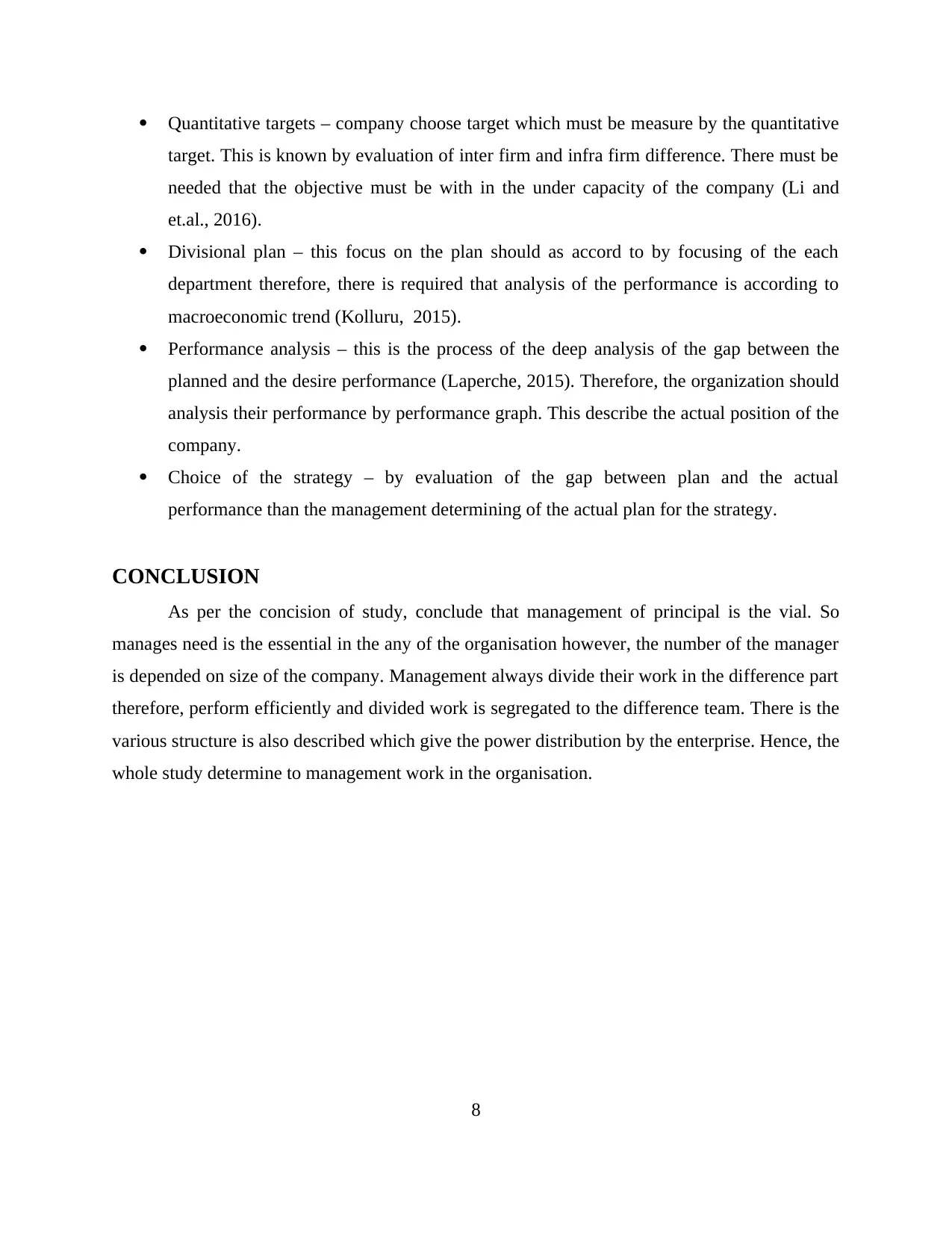
Quantitative targets – company choose target which must be measure by the quantitative
target. This is known by evaluation of inter firm and infra firm difference. There must be
needed that the objective must be with in the under capacity of the company (Li and
et.al., 2016).
Divisional plan – this focus on the plan should as accord to by focusing of the each
department therefore, there is required that analysis of the performance is according to
macroeconomic trend (Kolluru, 2015).
Performance analysis – this is the process of the deep analysis of the gap between the
planned and the desire performance (Laperche, 2015). Therefore, the organization should
analysis their performance by performance graph. This describe the actual position of the
company.
Choice of the strategy – by evaluation of the gap between plan and the actual
performance than the management determining of the actual plan for the strategy.
CONCLUSION
As per the concision of study, conclude that management of principal is the vial. So
manages need is the essential in the any of the organisation however, the number of the manager
is depended on size of the company. Management always divide their work in the difference part
therefore, perform efficiently and divided work is segregated to the difference team. There is the
various structure is also described which give the power distribution by the enterprise. Hence, the
whole study determine to management work in the organisation.
8
target. This is known by evaluation of inter firm and infra firm difference. There must be
needed that the objective must be with in the under capacity of the company (Li and
et.al., 2016).
Divisional plan – this focus on the plan should as accord to by focusing of the each
department therefore, there is required that analysis of the performance is according to
macroeconomic trend (Kolluru, 2015).
Performance analysis – this is the process of the deep analysis of the gap between the
planned and the desire performance (Laperche, 2015). Therefore, the organization should
analysis their performance by performance graph. This describe the actual position of the
company.
Choice of the strategy – by evaluation of the gap between plan and the actual
performance than the management determining of the actual plan for the strategy.
CONCLUSION
As per the concision of study, conclude that management of principal is the vial. So
manages need is the essential in the any of the organisation however, the number of the manager
is depended on size of the company. Management always divide their work in the difference part
therefore, perform efficiently and divided work is segregated to the difference team. There is the
various structure is also described which give the power distribution by the enterprise. Hence, the
whole study determine to management work in the organisation.
8
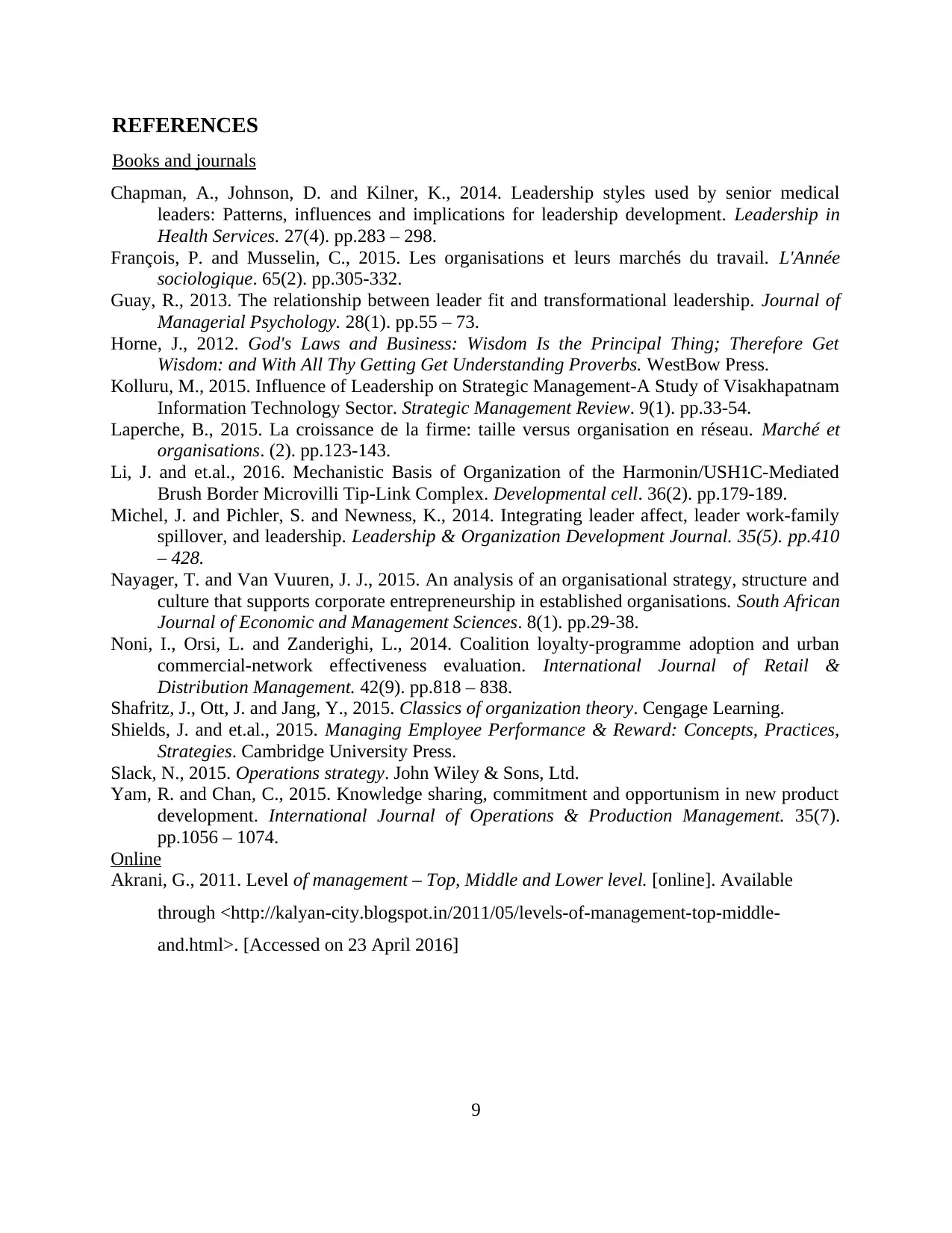
REFERENCES
Books and journals
Chapman, A., Johnson, D. and Kilner, K., 2014. Leadership styles used by senior medical
leaders: Patterns, influences and implications for leadership development. Leadership in
Health Services. 27(4). pp.283 – 298.
François, P. and Musselin, C., 2015. Les organisations et leurs marchés du travail. L'Année
sociologique. 65(2). pp.305-332.
Guay, R., 2013. The relationship between leader fit and transformational leadership. Journal of
Managerial Psychology. 28(1). pp.55 – 73.
Horne, J., 2012. God's Laws and Business: Wisdom Is the Principal Thing; Therefore Get
Wisdom: and With All Thy Getting Get Understanding Proverbs. WestBow Press.
Kolluru, M., 2015. Influence of Leadership on Strategic Management-A Study of Visakhapatnam
Information Technology Sector. Strategic Management Review. 9(1). pp.33-54.
Laperche, B., 2015. La croissance de la firme: taille versus organisation en réseau. Marché et
organisations. (2). pp.123-143.
Li, J. and et.al., 2016. Mechanistic Basis of Organization of the Harmonin/USH1C-Mediated
Brush Border Microvilli Tip-Link Complex. Developmental cell. 36(2). pp.179-189.
Michel, J. and Pichler, S. and Newness, K., 2014. Integrating leader affect, leader work-family
spillover, and leadership. Leadership & Organization Development Journal. 35(5). pp.410
– 428.
Nayager, T. and Van Vuuren, J. J., 2015. An analysis of an organisational strategy, structure and
culture that supports corporate entrepreneurship in established organisations. South African
Journal of Economic and Management Sciences. 8(1). pp.29-38.
Noni, I., Orsi, L. and Zanderighi, L., 2014. Coalition loyalty-programme adoption and urban
commercial-network effectiveness evaluation. International Journal of Retail &
Distribution Management. 42(9). pp.818 – 838.
Shafritz, J., Ott, J. and Jang, Y., 2015. Classics of organization theory. Cengage Learning.
Shields, J. and et.al., 2015. Managing Employee Performance & Reward: Concepts, Practices,
Strategies. Cambridge University Press.
Slack, N., 2015. Operations strategy. John Wiley & Sons, Ltd.
Yam, R. and Chan, C., 2015. Knowledge sharing, commitment and opportunism in new product
development. International Journal of Operations & Production Management. 35(7).
pp.1056 – 1074.
Online
Akrani, G., 2011. Level of management – Top, Middle and Lower level. [online]. Available
through <http://kalyan-city.blogspot.in/2011/05/levels-of-management-top-middle-
and.html>. [Accessed on 23 April 2016]
9
Books and journals
Chapman, A., Johnson, D. and Kilner, K., 2014. Leadership styles used by senior medical
leaders: Patterns, influences and implications for leadership development. Leadership in
Health Services. 27(4). pp.283 – 298.
François, P. and Musselin, C., 2015. Les organisations et leurs marchés du travail. L'Année
sociologique. 65(2). pp.305-332.
Guay, R., 2013. The relationship between leader fit and transformational leadership. Journal of
Managerial Psychology. 28(1). pp.55 – 73.
Horne, J., 2012. God's Laws and Business: Wisdom Is the Principal Thing; Therefore Get
Wisdom: and With All Thy Getting Get Understanding Proverbs. WestBow Press.
Kolluru, M., 2015. Influence of Leadership on Strategic Management-A Study of Visakhapatnam
Information Technology Sector. Strategic Management Review. 9(1). pp.33-54.
Laperche, B., 2015. La croissance de la firme: taille versus organisation en réseau. Marché et
organisations. (2). pp.123-143.
Li, J. and et.al., 2016. Mechanistic Basis of Organization of the Harmonin/USH1C-Mediated
Brush Border Microvilli Tip-Link Complex. Developmental cell. 36(2). pp.179-189.
Michel, J. and Pichler, S. and Newness, K., 2014. Integrating leader affect, leader work-family
spillover, and leadership. Leadership & Organization Development Journal. 35(5). pp.410
– 428.
Nayager, T. and Van Vuuren, J. J., 2015. An analysis of an organisational strategy, structure and
culture that supports corporate entrepreneurship in established organisations. South African
Journal of Economic and Management Sciences. 8(1). pp.29-38.
Noni, I., Orsi, L. and Zanderighi, L., 2014. Coalition loyalty-programme adoption and urban
commercial-network effectiveness evaluation. International Journal of Retail &
Distribution Management. 42(9). pp.818 – 838.
Shafritz, J., Ott, J. and Jang, Y., 2015. Classics of organization theory. Cengage Learning.
Shields, J. and et.al., 2015. Managing Employee Performance & Reward: Concepts, Practices,
Strategies. Cambridge University Press.
Slack, N., 2015. Operations strategy. John Wiley & Sons, Ltd.
Yam, R. and Chan, C., 2015. Knowledge sharing, commitment and opportunism in new product
development. International Journal of Operations & Production Management. 35(7).
pp.1056 – 1074.
Online
Akrani, G., 2011. Level of management – Top, Middle and Lower level. [online]. Available
through <http://kalyan-city.blogspot.in/2011/05/levels-of-management-top-middle-
and.html>. [Accessed on 23 April 2016]
9
⊘ This is a preview!⊘
Do you want full access?
Subscribe today to unlock all pages.

Trusted by 1+ million students worldwide
1 out of 9
Related Documents
Your All-in-One AI-Powered Toolkit for Academic Success.
+13062052269
info@desklib.com
Available 24*7 on WhatsApp / Email
![[object Object]](/_next/static/media/star-bottom.7253800d.svg)
Unlock your academic potential
Copyright © 2020–2025 A2Z Services. All Rights Reserved. Developed and managed by ZUCOL.





